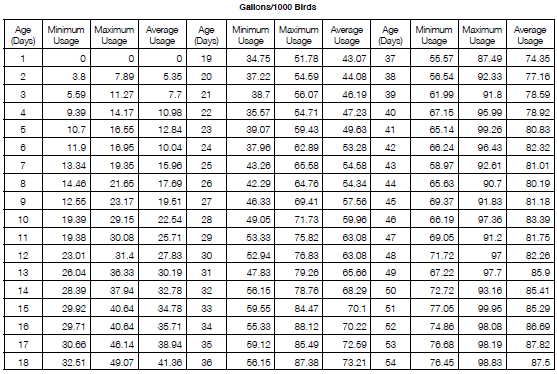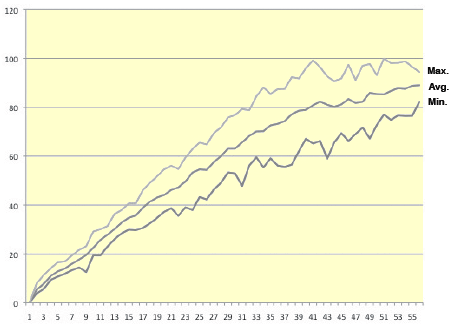



Broiler Water Consumption
Water consumption continues to be one of the simplest and most effective tools a poultry grower can use to monitor flock progress, according to Dr Susan Watkins and Dr G.T. Tabler of the University of Arkansas. They have monitored water intake daily over 12 consecutive flocks, reporting their results in the University's Avian Advice.Measuring water consumption of broilers can be an important tool for monitoring flock performance. Birds consume approximately 1.6 to 2.0 times as much water as feed (on a pound per pound basis); both feed and water consumption steadily increase as a flock ages.
Growers often ask: “Exactly how much should my birds be drinking each day and should I be concerned if water consumption does not increase every day?”
The daily water usage/consumption for the last twelve flocks at the Applied Broiler Research Farm (ABRF) (four commercial broiler houses) was analysed. Daily mortality was removed from the next day’s bird count so that water consumption reflected the actual bird number and not the placement number. Although the ABRF flocks are not always at the top of their settlement, average weights and feed conversions per flock are typically good so the following water usage is a realistic estimate.
As shown in Table 1 and Figure 1, overall daily water consumption steadily increases between one to almost four gallons per 1,000 birds but there were days when usage dropped or remained similar to the previous day’s usage. Consumption was also analysed by season: it was observed that water consumption was similar for all seasons until about day 18, when the hotter seasons began to show much higher water usage patterns. By day 21, consumption in the warmer seasons outpaced cooler season usage by as much as six to 10 gallons/1000 birds on a daily basis. Water usage dropped around the time the birds began eating the withdrawal feed for most flocks.


(gallons per 1,000 birds)
This observation has led us to evaluate some water treatment options that might help the birds adjust to the last feed. Since the ABRF settlements are good, the data presented here should encourage growers to not hit the panic button if flocks experience slight declines or a flat line in water usage for a day. However, there should be an increasing consumption trend. If water usage remains unchanged for more than a day or two, growers should try to identify the cause. A good check list to follow is:
- Drinker line height, too high or too low
- Air locks in the water system
- Water line pressure not correct for age of bird
- Clogged water filters or drinkers
- Dramatic change in light intensity
- Frequent changes in day length
- Feed changes or feed outages
- Water treatments /additives
- Birds are sick
- Too many birds per drinker (due to migration or bird placement numbers in the house)
Water consumption continues to be one of the simplest and most effective tools a poultry grower can use to monitor flock progress.
Growers who lack good flock water consumption guidelines can utilise the information from the ABRF as a guideline but are encouraged to develop their own usage patterns.
Identifying inconsistencies in water usage patterns can be a useful tool in establishing root causes of performance issues.
December 2009








